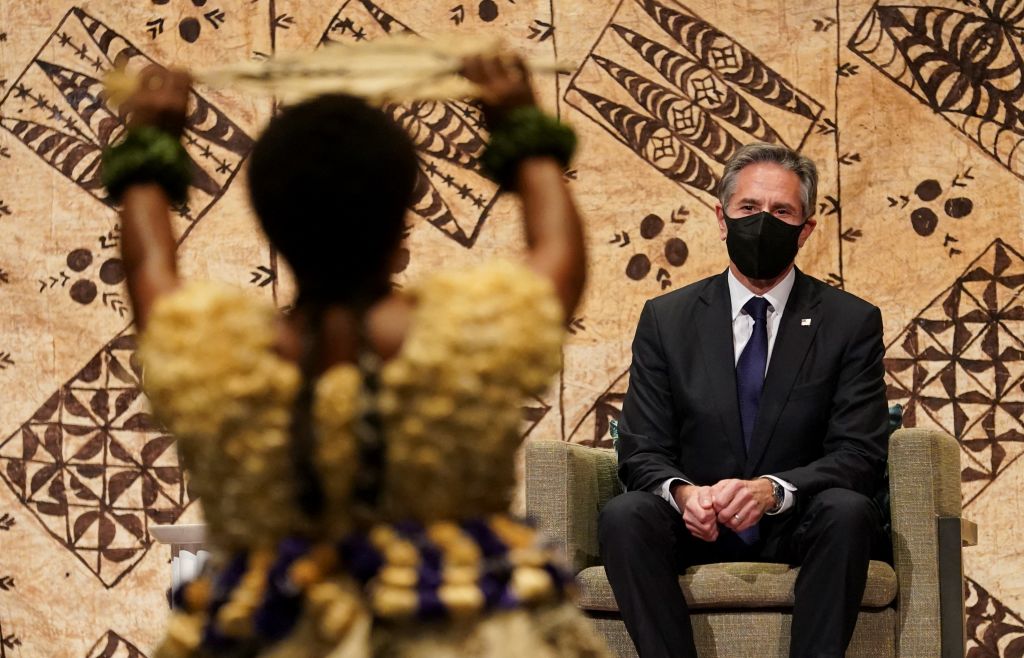
The first US summit with South Pacific leaders offers symbolism and the chance of future substance. The US announces, ‘We’re back!’
The summit on Wednesday and Thursday is a statement that the US can no longer leave Melanesia and Polynesia to Australia and New Zealand. That division of responsibilities worked well over 50 years. No more.
‘The United States now finds itself having to address long years of relative neglect,’ observes the former Australian diplomat Richard Maude. ‘US interests are largely defined by China’s gains.’
In this century, the global balance will be set in the Indo-Pacific, and that makes the South Pacific part of the great geostrategic struggle. At the summit, the South Pacific can sample the view and feel the weight that accompanies a new reality.
Setting up the Washington meeting with island leaders, the White House leaned on the symbolism:
The Summit will demonstrate the United States’ deep and enduring partnership with Pacific Island countries and the Pacific region that is underpinned by shared history, values, and people-to-people ties. The Summit will reflect our broadening and deepening cooperation on key issues such as climate change, pandemic response, economic recovery, maritime security, environmental protection, and advancing a free and open Indo-Pacific.
Rely on Washington to deliver great symbolism. The substance that must roll out in the months and years to come will need to reverse a long absence of mind.
The absence partly explains missteps on the initial guest list for the summit: no invites for Cook Islands, Niue, New Caledonia and French Polynesia, despite all being members of the Pacific Islands Forum.
In the same way, the State Department could this month summon up more than 50 examples of ‘new US assistance and ongoing engagement with the Pacific Islands as part of the Indo-Pacific Strategy’, but the only two references to the Pacific Islands Forum in the list were to its fisheries agency. One of the skills Washington will have to pick up is the ability to speak PIF.
See PIF-speak at its best in the superb act of imagination and region-building that is the Blue Pacific Continent. The US embraced this with the creation of the Partners in the Blue Pacific (founding members: Australia Japan, New Zealand, the United Kingdom) based on three principles: deliver results for the Pacific more effectively and efficiently, bolster Pacific regionalism, and expand opportunities for cooperation between the Pacific and the world.
Ahead of the Washington summit, the foreign ministers from the Partners in the Blue Pacific met in New York last week to lay out six lines of effort—climate change; technology and connectivity; the ocean and the environment; people; resources and economic development; and political leadership and regionalism—and to welcome Germany and Canada as prospective members.
The Blue Pacific partnership will offer a larger working of the wry line by US Indo-Pacific coordinator Kurt Campbell that Washington intends to be a ‘better deputy sheriff’ to Australia and New Zealand in the South Pacific. A more apt image is that the US intends to join a bigger and better posse. Cowboy language always works a treat for Washington, although not so much in PIF-speak.
Whatever the imagery, the substance must be a US that’s constantly present in the South Pacific and delivers for the islands’ people. Hear that from the doyen of Solomon Islands journalism, Dorothy Wickham, in her New York Times op-ed. She offers a simple lesson for the US as it vies with China for influence across the Pacific:
You have got to show up. And the United States has not.
We get it. The Solomon Islands is small, remote and economically insignificant. But if all countries like us are dismissed as such, China will pick us off one by one with its promises of business projects and development aid.
For decades, we identified with the West, a legacy forged when the United States, Australia and their allies halted Japan’s imperial advance during World War II in the Battle of Guadalcanal. But that was long ago. There is a creeping sense today that we are being ignored, if not forgotten. So who can blame us if we open the door to new friends who can help with our needs?
And those needs are great.
So, the US moves to re-establish an embassy in Solomon Islands, after closing it in 1993. The Honiara return was announced by Secretary of State Antony Blinken, during a speech in Suva—the first visit to Fiji by a US secretary of state since 1985. Spot a pattern?
The ‘we’re back’ message ran through the address to the PIF summit in July by Vice President Kamala Harris, promising a new chapter of partnership: ‘We recognize that in recent years, the Pacific Islands may not have received the diplomatic attention and support that you deserve. So today I am here to tell you directly: we are going to change that.’
Harris announced new US embassies in Tonga and Kiribati, the first US envoy to the forum, and the return of Peace Corps volunteers to the South Pacific.
Expect more on those lines from President Joe Biden this week. As ever, Washington will put on a great show.
While enjoying the pomp and attention, island leaders might note that other parts of the world are also getting a ‘we’re back’ embrace. The new US strategy towards sub-Saharan Africa released by the White House last month has similar language about reframing American policy to respond to ‘growing foreign activity and influence’.
Island leaders will have to find the positives in the US turning its eyes towards the southern hemisphere, whatever the regional context. They’ve had decades to understand that Washington is ever a world unto itself.
This week, though, Washington world meets the world of the islands, because much has changed in the world.
The chance for much more of substance from the US in the South Pacific will be the promise from a well-polished summit display of what Washington has to offer.

